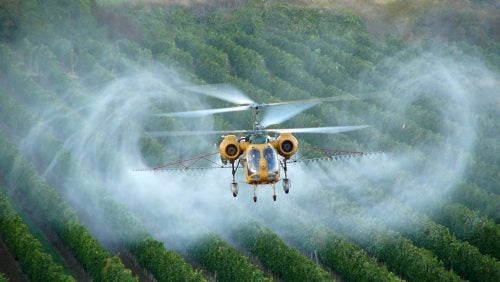Biden is Reevaluating Chlorpyrifos Pesticide—Why Not Also Atrazine?
February 19, 2021 by Sara Zaat

Helicopter spraying crops. Photo by Péter Czégény, licensed under https://creativecommons.org/licenses/by-sa/4.0/deed.en
The Biden administration recently released a list of agency actions it will review, many of which impact the environment.[1] One such remnant of the Trump administration is the regulation (or lack thereof) of a particularly pernicious pesticide: chlorpyrifos.[2] Used for insect control on crops, this organophosphate can cause dizziness, headaches, and nausea, and may even alter fetal brain development.[3] Continuing Obama’s effort to strictly regulate and potentially ban chlorpyrifos is an important step toward protecting vulnerable farmers, consumers, animals, and the broader environment.[4] Yet, another harmful pesticide—atrazine—is concerningly absent from Biden’s current review list.
Background on atrazine
Atrazine is the second most popular herbicide in America,[5] used mainly on corn, sugarcane, sorghum, and grass lawns.[6] A known endocrine disruptor and potential carcinogen, atrazine alters reproduction and development in humans and animals.[7] An estimated 44 million Americans had atrazine in their drinking water between 2015 and 2017.[8] Thirty-one countries have banned atrazine, including the European Union member states, which banned it in 2003.[9] Some scholars attribute the continued use of atrazine in the United States, despite its well-studied, toxic properties, to negotiations between the pesticide industry and the Environmental Protection Agency (EPA).[10] But in 2016, under Obama, the EPA examined atrazine in a draft risk assessment and concluded that atrazine was being released at levels harmful to plant and animal species.[11] Progress toward banning atrazine largely stalled in the Trump administration. Whatever the influence of industry may be today, the science on atrazine strongly indicates that the chemical is deleterious to human, animal, and environmental health, making it worthy of heightened scrutiny in the current administration.
Atrazine regulation in the Trump administration
The last action Trump’s EPA took on atrazine was a routine registration review re-approving atrazine with interim mitigation measures in September 2020.[12] Because of atrazine’s potential threat to endangered species, the registration review comes with a biological evaluation, which is open for public comment until mid-February 2021.[13] At least one farming organization is already advocating against this biological evaluation and for the continued use of atrazine, focusing on its potential to reduce greenhouse gas emissions and ignoring the science on its toxicity.[14] Seeking more than mere mitigation, some environmental groups are advocating to ban atrazine altogether. Last year, a number of environmental groups—the Center for Biological Diversity, the Center for Food Safety, the Rural Coalition, Pesticide Action Network North America, and Beyond Pesticides—sued the EPA for re-approving atrazine in the U.S. Court of Appeals for the Ninth Circuit.[15] The petitioners alleged violations of the EPA’s obligations to protect public health under the Federal Insecticide, Fungicide, and Rodenticide Act, or FIFRA.[16]
In August 2020, shortly before the lawsuit was filed, legislators introduced a new bill in Congress to update FIFRA: the Protect America’s Children from Toxic Pesticides Act of 2020 (PACTPA).[17] PACTPA would ban certain types of pesticides, including organophosphates like chlorpyrifos.[18] Triazines like atrazine, however, are left out of PACTPA. Thus, there is potential both in court—via the environmental groups’ lawsuit—and in Congress—through changes to a PACTPA re-introduced in the 117th Congress—for the federal government to crack down on atrazine.
Future atrazine regulation in the Biden administration
Although atrazine approval did not make the initial list of agency actions Biden officials will be reconsidering, chlorpyrifos did. That at least one toxic pesticide is being scrutinized may augur future reconsideration of atrazine. However, given that the Biden administration has yet to release plans to address atrazine, more action from attorneys and legislators signaling the importance of this widespread endocrine disruptor will likely be needed if atrazine is to be removed from the market and the environment.
[1] See Press Release, The White House, FACT SHEET: List of Agency Actions for Review (Jan. 20, 2021), https://www.whitehouse.gov/briefing-room/statements-releases/2021/01/20/fact-sheet-list-of-agency-actions-for-review/.
[2] Id.
[3] Dan Charles, Toxic Pesticide Faces New Scrutiny From Biden Administration, National Public Radio (Jan. 20, 2021), https://www.npr.org/sections/inauguration-day-live-updates/2021/01/20/958925222/toxic-pesticide-faces-new-scrutiny-from-biden-administration [https://perma.cc/D2Q3-QGVT].
[4] See id.
[5] Karen R. Ryberg, Atrazine concentrations have decreased in streams and rivers across the United States, U.S. Geological Service (Mar. 3, 2020),
https://www.usgs.gov/center-news/atrazine-concentrations-have-decreased-streams-and-rivers-across-united-states?qt-news_science_products=1#qt-news_science_products [https://perma.cc/V5P5-2S5J].
[6] Todd Neeley, EPA Extends Herbicides’ Comment Period, Progressive Farmer (Dec. 23, 2020),
https://www.dtnpf.com/agriculture/web/ag/crops/article/2020/12/23/public-extra-45-days-comment-draft [https://perma.cc/29UB-D9AG].
[7] Jennifer Beth Sass & Aaron Colangelo, European Union Bans Atrazine, While the United States Negotiates Continued Use, 12 Int. J. Occup. Environ. Health 260 (July-Sept. 2006), https://pubmed.ncbi.nlm.nih.gov/16967834/; Tyrone B. Hayes et al., Atrazine Induces Complete Feminization and Chemical Castration in Male African Clawed Frogs (Xenopus laevis), 107 Proc. Nat’l Acad. Sci. 4612 (Mar. 9, 2010), https://www.pnas.org/content/107/10/4612.
[8] Atrazine, Environmental Working Group, https://www.ewg.org/tapwater/contaminant.php?contamcode=2050 [https://perma.cc/RTT4-3VX9] (last visited Feb. 8, 2021).
[9] Sass & Colangelo, supra note 7; Colin O’Neil & Alexis Temkin, What the Biden Administration Should Do To Protect Children From Toxic Pesticides, Environmental Working Group (Jan. 22, 2021), https://www.ewg.org/news-and-analysis/2021/01/what-biden-administration-should-do-protect-children-toxic-pesticides [https://perma.cc/83VF-BSSK].
[10] Sass & Colangelo, supra note 7.
[11] See Draft Ecological Risk Assessments for Triazines, U.S. Environmental Protection Agency,
https://www.epa.gov/ingredients-used-pesticide-products/draft-ecological-risk-assessments-triazines [https://perma.cc/5RVS-5KNW] (last updated June 19, 2017).
[12] See Todd Neeley, supra note 6.
[13] Id.
[14] Write EPA to Protect the Use of Atrazine in Crop Production, American Farm Bureau Federation, https://www.fb.org/advocacy/grassroots-and-political-advocacy/write-epa-to-protect-the-use-of-atrazine-in-crop-production/ [https://perma.cc/N6QK-SB4S] (last visited Feb. 13, 2021).
[15] Todd Neeley, EPA Sued Over Atrazine, Progressive Farmer (Nov. 2, 2020), https://www.dtnpf.com/agriculture/web/ag/crops/article/2020/11/02/environmental-groups-allege-epa-law [https://perma.cc/PE5K-EW4Z]. For the text of the petition, see Petition for Review, Rural Coalition v. EPA, No. 20-73220 (9th Cir. Oct. 30, 2020), https://www.centerforfoodsafety.org/files/2020-10-30–ecf-1-6–petition-for-review_83625.pdf [https://perma.cc/WLU7-JPY7].
15 Neeley, supra note 15.
16 Protect America’s Children from Toxic Pesticides Act, S. 4406, 116th Cong. (2020), https://www.congress.gov/bill/116th-congress/senate-bill/4406/text.
17 Id § 9.

